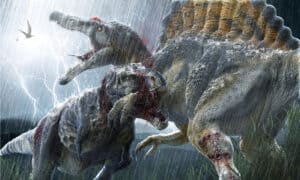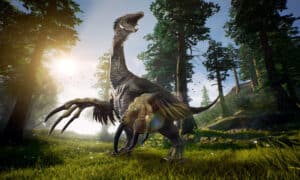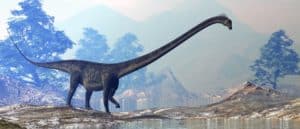Most of the largest animals ever to roam the earth lived millions of years ago. These were the largest prehistoric animals to walk the earth. Today, our largest animals swim in the ocean. The blue whale can achieve a size up to 98 feet long and weigh 150 tons. But is the blue whale the most gigantic animal ever to live on planet Earth?
Let’s dive into the largest prehistoric animals!
Massive Prehistoric Dinosaurs
Millions of years ago, even larger animals were walking across the world. Paleontologists called these animals dinosaurs, and we only know about them because of fossils. Fossils are old bones and even imprints of animals that paleontologists and others have found in rocks. So, many of the animals we know today as dinosaurs were first discovered as pieces of bone. Additionally, experts have located three distinct species of these giant dinosaurs over time. They found the first of these three species in 2000 and another even bigger one in 2005. Finally, experts found the biggest of the three in 2013.
Needless to say, with new fossils found every year the debate of which dinosaur grew the largest will rage for a long time to come!
Titanosaurs – Cretaceous Period (145 to 66 Million Years Ago)
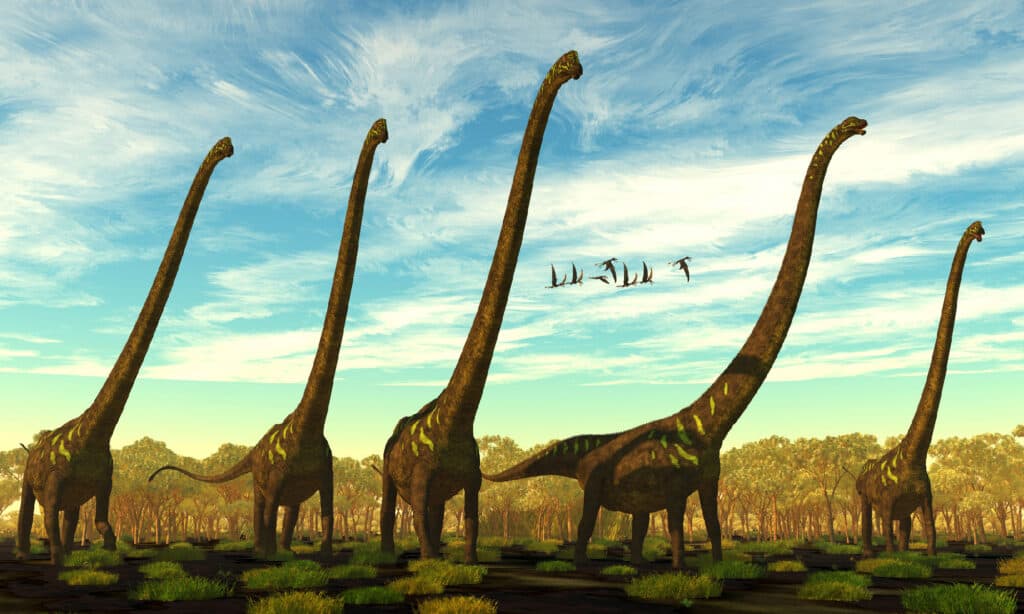
Titanosaurs were massive and featured long necks that allowed them to eat a wide array of plants and trees.
©iStock.com/CoreyFord
Titanosaurs were the largest of the dinosaurs that scientists have ever discovered. They lived during the Earth’s Cretaceous Period, and recently, paleontologists have uncovered Titanosaur fossils on every continent. For example, in 2017, someone found the fossilized remains of a Titanosaur in Argentina, dating back about 100 million years.
1. Patagotitan Mayorum: A Large Prehistoric 70 Tons
Paleontologists named the Patagotitan mayorum in 2017. This large prehistoric mammal had a long neck, lived on the land, grew to about 120 feet tall, and weighed up to 70 tons. Scientists believe that they were the largest terrestrial animals that ever existed. They base their belief on a thighbone with an overall length of 8 feet.
Between its discovery in 2013 and its official naming in August 2017, Patagotitan was known as a Titanosaur because of its enormous size. The species was present between 100 million and 95 million years ago. Paleontologists classified the Patagotitans as herbivorous sauropods. All of them had long necks and tails and stood on all fours. The Patagotitan likely fed on leaves and used their long necks to reach into the tall trees.
2. Argentinosaurus – An 85 Ton Mammoth
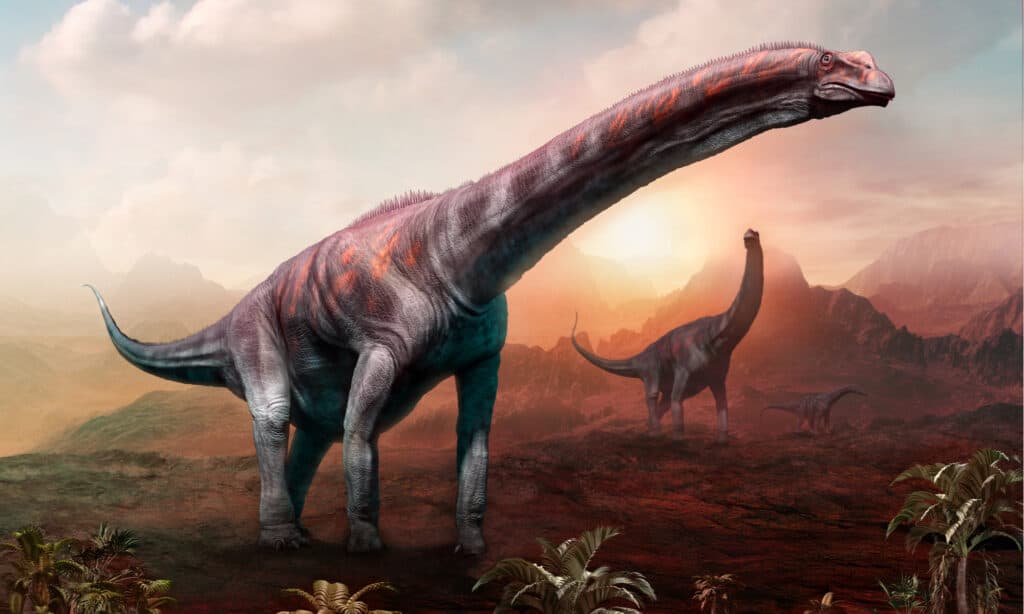
Argentinosaurus weighed a massive 85 tons and grew to 98 feet tall. A farmer discovered the first fossil of this prehistoric animal in Argentina in 1987.
©Warpaint/Shutterstock.com
In 1987 an Argentinian farmer discovered a piece of petrified wood as big as a man. Analysis of the wood identified it as part of an unknown dinosaur species. This giant would later be named Argentinosaurus Huinculensis. Unfortunately, people have only ever found fragments of Argentinosaurus skeletons. But scientists believe that Argentinosaurus was 98 feet long and weighed 85 tons. Still, earlier estimates were at a much more significant size, but scientists adjusted these to the current proportions. Scientists believe that Argentinosaurus lived in groups of 20, foraged in areas of dense vegetation, and consumed leaves and fruits from conifers.
3. Dreadnoughtus – A Smaller 65 Tons
Dreadnoughtus schrani fossils were discovered in an Argentinian rock formation in 2014. Scientists estimated that Dreadnoughtus was 30 feet tall and had a neck of 37 feet long. Their approximate height was estimated at 85 feet with a weight of 65 tons, making this one of the most gigantic land dwellers ever. Initially, only two incomplete fossils of Dreadnoughtus were found in 2013. Scientists estimated their size using a more complete skeleton containing parts of a skull and teeth. Dreadnoughtus was an herbivore and likely used its long neck to reach branches and leaves on tall trees. In addition, scientists think Dreadnoughtus may have used its tail as a weapon against predators.
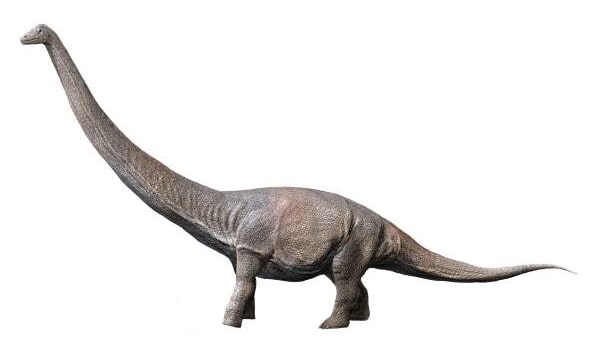
The Dreadnoughtus is one of the largest animals discovered in history.
©Nobu Tamura email:[email protected] http://spinops.blogspot.com / CC BY-SA 4.0 – License
4. Giganotosaurus Carolinii – A Small Prehistoric 15 Tons
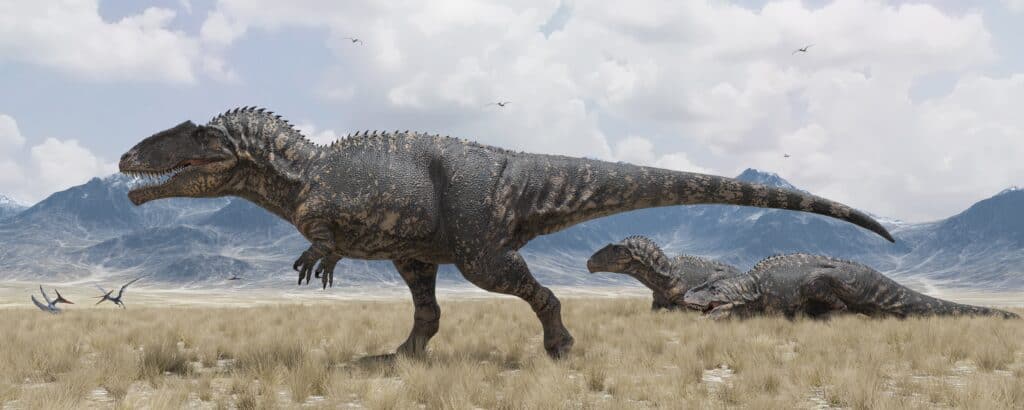
Giganotosaurus Carolinii weighed 10 to 15 tons, was 45 feet tall, and bigger than the Tyrannosaurus Rex.
©Herschel Hoffmeyer/Shutterstock.com
99.6 million years ago, a massive flesh-eating dinosaur roamed around modern-day Argentina. Fossils of Giganotosaurus were unearthed in El Cochon, Argentina, in 1993. Giganotosaurus should not be confused with Gigantosaurus, an herbivore from the Great Britain region. Giganotosaurus Carolinii weighed 10 tons and was 45 feet tall. New studies show that Giganotosaurus may even have reached a weight of 15 tons. This weight makes Gigantosaurus bigger than the Tyrannosaurus Rex, who scientists previously believed to be the biggest carnivorous dinosaur.
Giganotosaurus shared the Earth with Titanosaurs like the Dreadnoughtus and Patagotitan and likely hunted them. Giganotosaurus is closely related to the Allosaurs. Like its Allosaur cousins, Giganotosaurus walked upright. It had short forearms with three fingers and claws on each forepaw. Scientists estimate that Giganotosaurus could run up to 31.3 mph. This speed makes it faster than Tyrannosaurus, which was estimated only to run at 25 mph. Of course, there remains considerable debate about the speed of these massive dinosaurs!
5. Hatzegopteryx – A Giant of the Sky
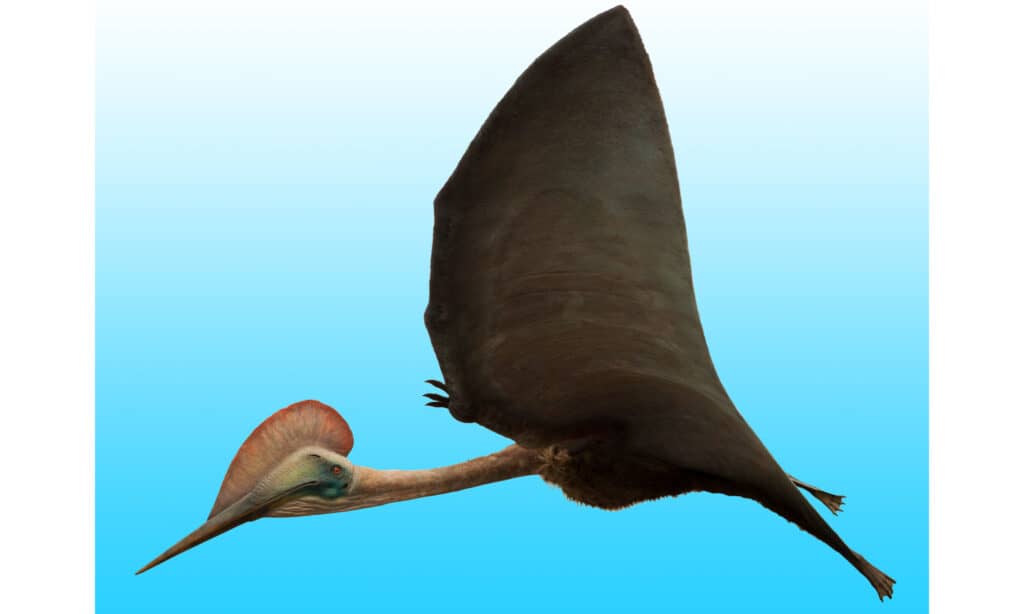
Azhdarchids like the Hatzegopteryx stood 18 feet tall, weighed approximately 250 pounds, and had a wingspan of 40 feet.
©Arctium Lappa/Shutterstock.com
250 pounds might not sound much compared to 85 ton dinosaurs, but just consider that the heaviest flying animal in the world today weighs just 45 pounds!
During the late Cretaceous period, a massive giant dominated the skies over Hatzeg Island, an area of land that was separated from mainland Europe. People uncovered the first fossil of Hatzegopteryx in the Hatzeg Basin, later finding more in regions of Romania and Transylvania. This sizeable flying pterosaur was named Hatzegopteryx Thambema. Hatzegopteryx stood 18 feet tall, weighed approximately 250 pounds, and had a wingspan of 40 feet.
This ancient creature had an extremely heavy skull and was exceptionally strong. Scientists believe that Hatzegopteryx behaved like the storks and herons we see today. It likely caught and ate smaller dinosaurs and fish. Hatzegopteryx also probably had to take several jumps to launch itself into the air due to its weight. Scientists are still speculating whether these giant beasts flew or only soared through the skies.
6. Quetzalcoatlus – An Enormous 500 Pounds Apex Predator of the Sky
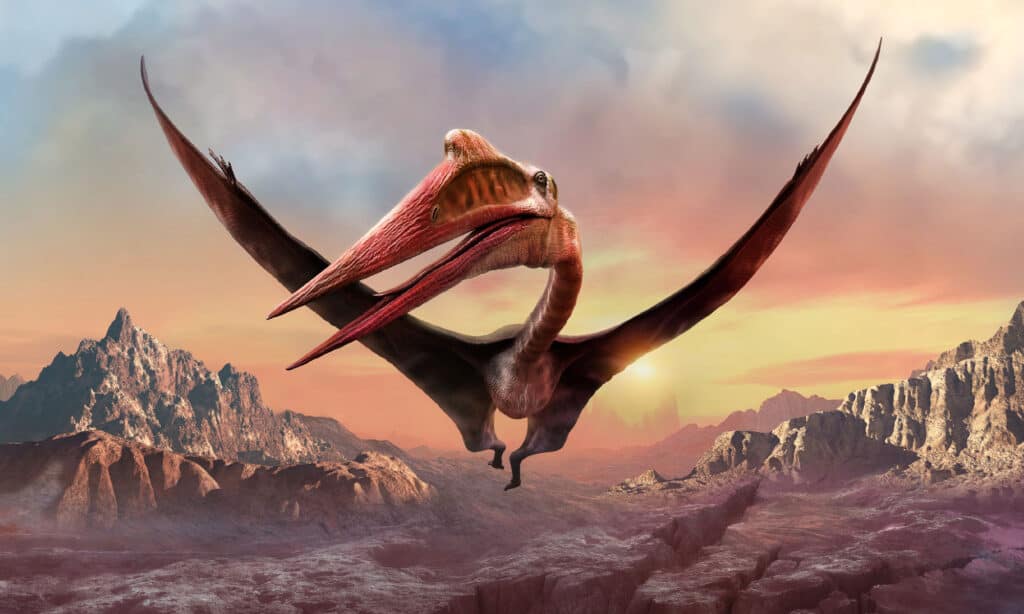
The largest prehistoric flying dinosaur or more accurately, the Quetzalcoatlus, weighed between 400 and 500 pounds, grew 16 feet tall, and had a wingspan of 39 feet.
©iStock.com/Warpaintcobra
Seventy million years ago, a giant flying dinosaur stalked the marshlands of the modern Rio Grande. Quetzalcoatlus Northropi was one of the largest Pterosaurs ever to fly. This mammoth creature had a wingspan of 39 feet and stood 16 feet tall. Weight estimates on the Quetzalcoatlus place it in the region of 400 to 500 pounds. Experts unearthed fossils of this massive Pterosaur in 1971 in Texas. However, they know little about its diet, but scientists speculate that it may have caught fish or scavenged for carrion.
Quetzalcoatlus likely acted like today’s herons, prowling waterways to snare fish and other food items. Experts don’t know much about how these giant pterosaurs launched themselves into the air but believe they did running jumps like the Hatzegopteryx to become airborne. Alternatively, scientists think they might have jumped from cliffs to fly.
Summary of the 6 Largest Prehistoric Animals Ever
| 1 | Animal | Size |
|---|---|---|
| 1 | Patagotitan Mayorum | 70 Tons |
| 2 | Argentinosaurus | 85 Tons |
| 3 | Dreadnoughtus | 65 Tons |
| 4 | Giganotosaurus Carolinii | 15 Tons |
| 5 | Hatzegopteryx | 250 Pounds |
| 6 | Quetzalcoatlus | 500 Pounds |
The photo featured at the top of this post is © iStock.com/CoreyFord
Thank you for reading! Have some feedback for us? Contact the AZ Animals editorial team.




